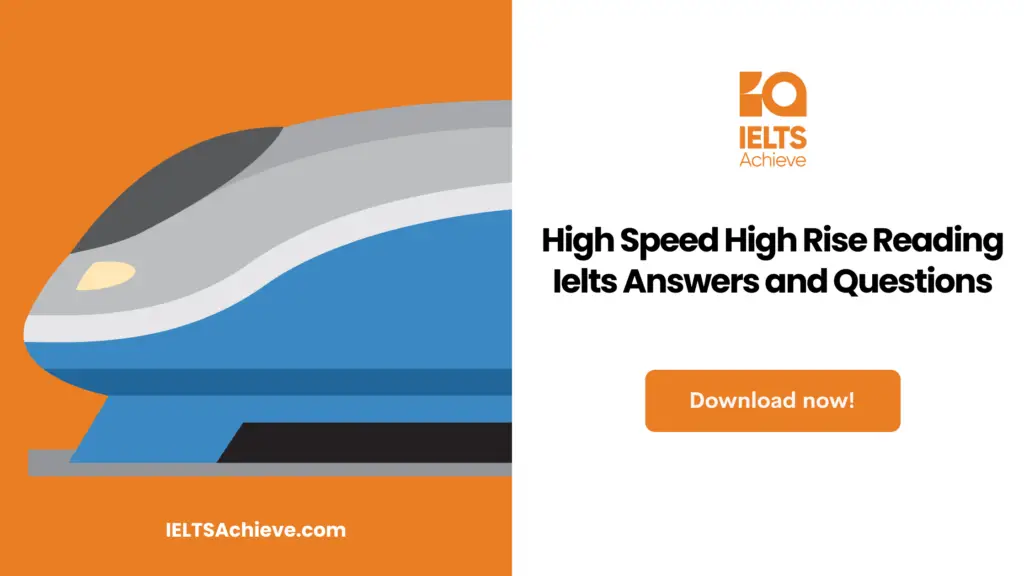The Blog post contains the following IELTS Reading Questions:
- IELTS Reading Matching Headings.
- IELTS Reading Diagram Completion.
- IELTS Reading Sentence Completion.
Stay informed and prepared for success – Explore our comprehensive Reading Test Info page to get valuable insights, exam format details, and expert tips for mastering the IELTS Reading section.
IELTS Reading Passage – High speed high rise

High Speed High Rise
A Chinese manufacturer has developed a method for producing 30-story, earthquake-resistant skyscrapers that assemble in just 15 days.
Broad Sustainable Building, also known as “Broad,” was founded and is led by Zhang Yue. On January 1, 2012, a time-lapse film of the 30-story feat was made public. A clock in the bottom-right corner of the screen displays the time as construction workers are seen scurrying about like gnats. A 100-meter-tall tower known as the T30 will be built to overlook the Xiang River in Hunan in under 360 hours from an empty plot. The Broad logo, a lowercase letter that wraps around itself in imitation of the @ symbol, emerges on the screen when the camera circles the building overhead at the end of the video. The business is currently franchising its technology to collaborators in Russia, Brazil, and India. The first standardized skyscraper in the world is what it is offering, and Zhang hopes to make Broad the McDonald’s of the sustainable building sector with it. Zhang responds, “It’s not a construction company,” when asked why he chose to launch a business in the construction industry. It is a structural revolution.
Broad has so far erected 16 structures in China and one more in Cancun. Two facilities in Hunan, about an hour’s drive from Broad Town, the expansive headquarters, are where they are made. The components used to construct the skyscrapers’ floors and ceilings have dimensions of 15.6 by 3.9 meters and a depth of 45 cm. Each floor module is threaded with pipes and ducts for power, water, and garbage while it is still in the factory. Additionally, the flooring of the client’s choice is pre-installed on top. Two modules are delivered to the construction site in standardized truckloads, each containing the required columns, bolts, and equipment to connect them. When they go to the building, which is put together like a set of toy Lego bricks, a crane lifts each part right to the top. Workers connect the pipes and cables swiftly using the materials on the module. The distinctive column design incorporates tabs that bolt into the floors above and below and diagonal bracing at either end. The last process is crane-slotting in the outer walls and windows that are highly insulated. The outcome is by no means appealing, but the technique is surprisingly safe and astonishingly quick.
Zhang credits his inventiveness and outsider viewpoint on technology for his achievement. In the 1980s, Zhang was a student of art, but he quit the field in 1988 to develop Broad. The business originally produced non-pressurized boilers. He built his fortune on boilers, according to Juliet Jiang, his senior vice president. Although he could have continued his business, he realized the importance of nonelectric air conditioning. She argues that by the end of the decade, China’s economy had outgrown the country’s electrical grid. Power shortages were starting to pose a significant threat to growth. Large natural gas-powered air conditioning (AC) machines might save energy costs, cut operating expenses, and provide more dependable climate control for businesses. Today, Broad operates facilities in more than 70 nations, including some of the world’s biggest structures and airports.
The AC company of Zhang was booming in the past 20 years. But a number of things happened in concert to alter his course. Zhang first became an environmentalist. The second occurred in 2008 when an earthquake struck the Sichuan Province of China, resulting in the collapse of several shoddy structures. He claims that in the beginning, he sought to persuade developers to retrofit existing structures in order to make them more solid and sustainable, but he wasn’t very successful. Zhang then hired his own engineers and began investigating ways to create affordable, ecologically friendly buildings that could survive earthquakes. After six months of investigation, Zhang had given up on using conventional techniques. The expense of employing designers and specialists for each new construction irritated him. He determined that moving the building to the factory was the best approach to reduce expenses. However, Broad had to stray from accepted architectural practices in order to build a skyscraper in a factory. It was necessary to change the load-bearing structure as a whole. Less concrete was used in the floors to reduce the building’s overall weight, which allowed for a reduction in structural steel.
Prefabricated and modular buildings are becoming more and more well-liked all around the world. However, prefabricated and modular structures elsewhere are often low-rise. Only Broad uses these techniques for buildings. Zhang believes that the environmental benefits alone are worth the effort. A conventional high-rise will generate approximately 3,000 tons of construction debris, while a Broad structure will generate only 25 tons, according to Broad’s calculations. Broad structures consume no water during construction, in contrast to traditional buildings, which use 5,000 tons of water. Additionally, construction is less risky. The risk of injury can be reduced by installing elevator systems at the factory, including the base, rails, and machine room. Additionally, Broad orders a finished elevator car and drops it into the shaft using a crane rather than bringing it to the location in sections. The goal of elevator manufacturers is to preinstall the doors in the future, entirely removing the possibility that a worker could trip and fall. He claims that conventional construction is disorganized. “We moved construction into the factory,” the statement reads. Zhang claims that his structures will help address the myriad issues facing the construction industry and that they will also be easier and less expensive to create.
Unlock your full potential in the IELTS Reading section – Visit our IELTS Reading Practice Question Answer page now!
Recommended Questions:
Renewable Energy IELTS Reading Question with Answer
High Speed High Rise IELTS Reading Questions
Question 1-5
In the question, you will find a list of headings provided from I to VIII. Each heading will put forward the main idea of the paragraph in the text.
List of headings:
- A joint enterprise project
- Additional engineering successes
- Looking at the overall advantages
- A distinctive structure
- Traditional techniques have several advantages.
- A shift in course
- Worldwide brands that are comparable examples
- Construction site and factory
Ready to conquer Matching Headings questions? Click here to learn essential tips and techniques for matching headings accurately to paragraphs or sections in the IELTS Reading section.
Question 6-9
Label the diagram You can use ONLY ONE WORD, to fill in the answer.
5. Pipes and ducts installed while in ___________.
6. Chosen by customer ___________
7. Diagonal bracing at top and bottom of ___________
8. Section contains less __________ than a conventional building.

Ready to tackle Diagram Label Completion tasks with confidence? Click here to access our comprehensive guide and learn how to accurately label parts or components of diagrams in the IELTS Reading section.
Question 10-13
Choose No More than two words can be used to answer the question. In the answer box, you need to fill the answer with the help of one or two words.
10. Zhang describes his company as a _______.
11. The very first goods produced by Broad were _______.
12. In China, _______ were impeding industrial development in the late 1980s.
13. Broad’s AC units increase ______ along with power and cost advantages.
Enhance your sentence completion skills in the IELTS Reading section. Click here to access our comprehensive guide and learn effective strategies for filling in missing words or phrases in sentences.
Unlock your full potential in the IELTS Reading section – Visit our IELTS Reading Practice Question Answer page now!
Recommended Questions:
Renewable Energy IELTS Reading Question with Answer
High speed high rise Reading Answers
1. IV
2. VIII
3. VI
4. III
5. FACTORY
6. FLOORING OR FLOOR
7. COLUMN
8. CONCRET
9. STRUCTURAL REVOLUTION
10. [NON-PRESSURIZED] BOILERS
12. POWER SHORTAGE
13. CLIMATE CONTROL

We hope you found this post useful in helping you to study for the IELTS Test. If you have any questions please let us know in the comments below or on the Facebook page.
The best way to keep up to date with posts like this is to like us on Facebook, then follow us on Instagram and Pinterest. If you need help preparing for the IELTS Test, join the IELTS Achieve Academy and see how we can assist you to achieve your desired band score. We offer an essay correction service, mock exams and online courses.

